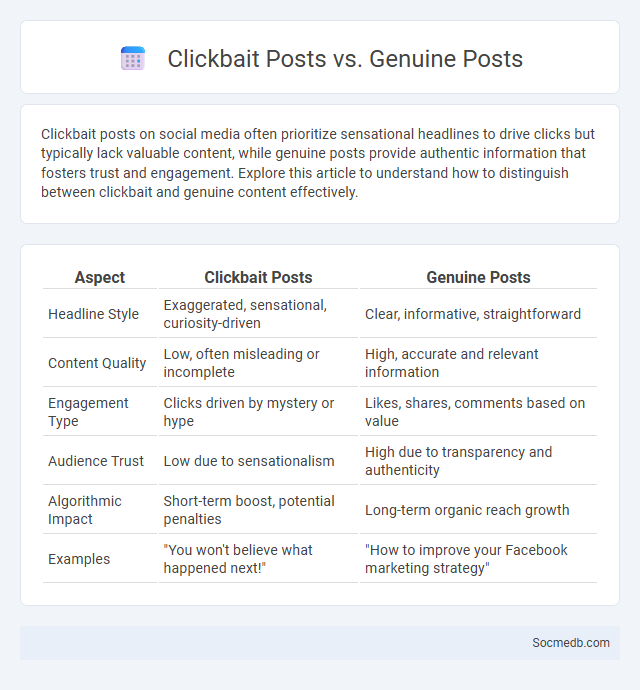
Photo illustration: Clickbait posts vs genuine posts
Clickbait posts on social media often prioritize sensational headlines to drive clicks but typically lack valuable content, while genuine posts provide authentic information that fosters trust and engagement. Explore this article to understand how to distinguish between clickbait and genuine content effectively.
Table of Comparison
| Aspect | Clickbait Posts | Genuine Posts |
|---|---|---|
| Headline Style | Exaggerated, sensational, curiosity-driven | Clear, informative, straightforward |
| Content Quality | Low, often misleading or incomplete | High, accurate and relevant information |
| Engagement Type | Clicks driven by mystery or hype | Likes, shares, comments based on value |
| Audience Trust | Low due to sensationalism | High due to transparency and authenticity |
| Algorithmic Impact | Short-term boost, potential penalties | Long-term organic reach growth |
| Examples | "You won't believe what happened next!" | "How to improve your Facebook marketing strategy" |
Understanding Clickbait: Definition and Purpose
Clickbait refers to sensationalized or misleading headlines designed to attract clicks and drive traffic to websites, often prioritizing engagement over content accuracy. This tactic exploits human curiosity and emotions to increase page views, ad revenue, and social media shares. Understanding clickbait is essential for users to critically evaluate online content and avoid misinformation.
Genuine Posts: Characteristics and Value
Genuine posts on social media are characterized by authenticity, transparency, and relatable content that resonates deeply with your audience. These posts foster trust and engagement by reflecting real experiences and emotions rather than curated perfection. Prioritizing genuine interactions enhances your brand's credibility and cultivates a loyal community invested in your message.
Clickbait vs Genuine Content: Key Differences
Clickbait content relies on sensationalized headlines and exaggerated claims to attract clicks, often sacrificing accuracy and user trust. Genuine content provides valuable, truthful information that builds long-term audience engagement and credibility. Social media algorithms increasingly prioritize authentic content to enhance user experience and reduce misinformation.
Emotional Manipulation in Clickbait Titles
Clickbait titles on social media often exploit emotional manipulation by triggering feelings like curiosity, fear, or anger to compel users to click. These titles use sensational language and psychological tactics designed to bypass rational judgment, increasing engagement at the cost of user trust. Understanding these techniques helps You critically evaluate content and avoid being manipulated by misleading headlines.
Audience Engagement: Clickbait vs Authentic Posts
Audience engagement on social media significantly varies between clickbait and authentic posts, with authentic content generating higher trust and longer-lasting interactions. Authentic posts foster meaningful conversations and promote brand loyalty by providing genuine value and relatable narratives. Clickbait strategies may trigger short-term spikes in clicks but often lead to reduced credibility and diminished user retention over time.
The Psychology Behind Clickbait Consumption
Clickbait exploits cognitive biases by triggering curiosity gaps and emotional reactions, compelling users to click without fully realizing the manipulative intent. The brain's reward system is activated by sensational headlines, releasing dopamine that reinforces the behavior of engaging with such content. This psychological manipulation exploits attention scarcity and the need for social validation, making clickbait an effective tool for driving traffic on social media platforms.
Trustworthiness and Credibility in Posts
Trustworthiness and credibility in social media posts are essential for building authentic connections and maintaining audience engagement. Verified accounts, transparent sourcing, and consistent fact-checking significantly enhance the reliability of shared content. User-generated feedback and platform algorithms also play a crucial role in promoting credible information and reducing the spread of misinformation.
Impact on Social Media Algorithms
Social media algorithms analyze user behavior, preferences, and engagement patterns to personalize content feeds, ensuring your experience is tailored and relevant. These algorithms prioritize posts that generate higher interaction rates, such as likes, comments, and shares, which can amplify visibility and influence public opinion. Understanding the impact of these algorithms helps you navigate digital spaces more effectively, enhancing your ability to connect with targeted audiences and optimize your social media presence.
Ethical Considerations in Content Creation
Creating content on social media requires careful attention to ethical considerations such as respecting privacy, avoiding misinformation, and promoting respectful dialogue. You must ensure that your posts do not exploit sensitive topics or harm vulnerable groups while maintaining transparency about sponsored content. Adhering to these ethical principles fosters trust and credibility within your online community.
Tips for Identifying Clickbait vs Genuine Posts
Identifying clickbait involves scrutinizing sensational headlines that exaggeratedly promise shocking revelations, whereas genuine posts provide clear, informative content with credible sources or evidence. You should verify the reliability of the publisher and check for consistent messaging across multiple trustworthy platforms. Paying attention to the balance between emotional appeal and factual information helps differentiate authentic posts from manipulative clickbait.
 socmedb.com
socmedb.com